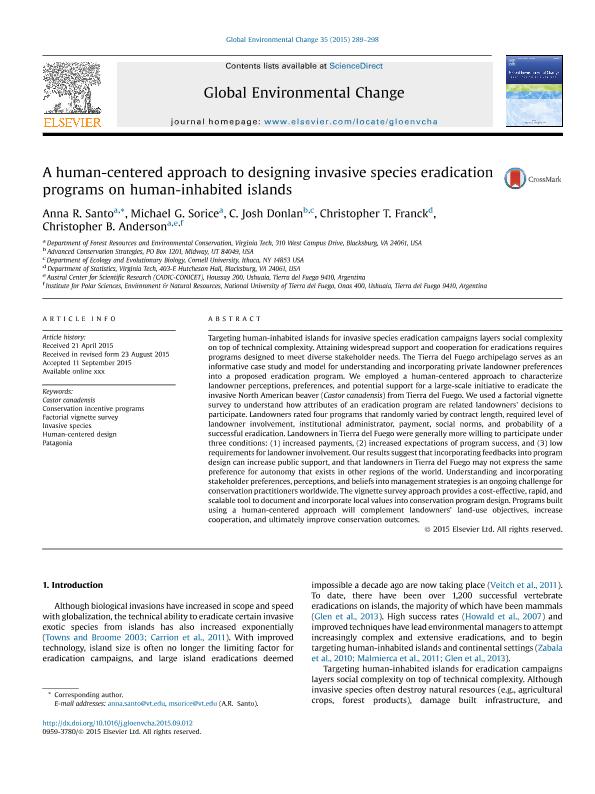Mostrar el registro sencillo del ítem
dc.contributor.author
Santo, Anna
dc.contributor.author
Sorice, Michael G.
dc.contributor.author
Donlan, C. Josh
dc.contributor.author
Franck, Christopher T.
dc.contributor.author
Anderson, Christopher Brian

dc.date.available
2016-04-28T20:14:36Z
dc.date.issued
2015-10
dc.identifier.citation
Santo, Anna; Sorice, Michael G.; Donlan, C. Josh; Franck, Christopher T.; Anderson, Christopher Brian; A human-centered approach to designing invasive species eradication programs on human-inhabited islands; Elsevier; Global Environmental Change; 35; 10-2015; 289-298
dc.identifier.issn
0959-3780
dc.identifier.uri
http://hdl.handle.net/11336/5435
dc.description.abstract
Targeting human-inhabited islands for invasive species eradication campaigns layers social complexity on top of technical complexity. Attaining widespread support and cooperation for eradications requires programs designed to meet diverse stakeholder needs. The Tierra del Fuego archipelago serves as an informative case study and model for understanding and incorporating private landowner preferences into a proposed eradication program. We employed a human-centered approach to characterize landowner perceptions, preferences, and potential support for a large-scale initiative to eradicate the invasive North American beaver (Castor canadensis) from Tierra del Fuego. We used a factorial vignette survey to understand how attributes of an eradication program are related landowners' decisions to participate. Landowners rated four programs that randomly varied by contract length, required level of landowner involvement, institutional administrator, payment, social norms, and probability of a successful eradication. Landowners in Tierra del Fuego were generally more willing to participate under three conditions: (1) increased payments, (2) increased expectations of program success, and (3) low requirements for landowner involvement. Our results suggest that incorporating feedbacks into program design can increase public support, and that landowners in Tierra del Fuego may not express the same preference for autonomy that exists in other regions of the world. Understanding and incorporating stakeholder preferences, perceptions, and beliefs into management strategies is an ongoing challenge for conservation practitioners worldwide. The vignette survey approach provides a cost-effective, rapid, and scalable tool to document and incorporate local values into conservation program design. Programs built using a human-centered approach will complement landowners’ land-use objectives, increase cooperation, and ultimately improve conservation outcomes.
dc.format
application/pdf
dc.language.iso
eng
dc.publisher
Elsevier

dc.rights
info:eu-repo/semantics/openAccess
dc.rights.uri
https://creativecommons.org/licenses/by-nc-nd/2.5/ar/
dc.subject
Castor Canadensis
dc.subject
Conservation Incentive Programs
dc.subject
Factorial Vignette Survey
dc.subject
Invasive Species
dc.subject.classification
Ciencias Medioambientales

dc.subject.classification
Ciencias de la Tierra y relacionadas con el Medio Ambiente

dc.subject.classification
CIENCIAS NATURALES Y EXACTAS

dc.title
A human-centered approach to designing invasive species eradication programs on human-inhabited islands
dc.type
info:eu-repo/semantics/article
dc.type
info:ar-repo/semantics/artículo
dc.type
info:eu-repo/semantics/publishedVersion
dc.date.updated
2016-05-06 15:52:43.262787-03
dc.journal.volume
35
dc.journal.pagination
289-298
dc.journal.pais
Países Bajos

dc.journal.ciudad
Amsterdam
dc.description.fil
Fil: Santo, Anna. Virginia Tech University; Estados Unidos
dc.description.fil
Fil: Sorice, Michael G.. Advanced Conservation Strategies; Estados Unidos. Cornell University; Estados Unidos
dc.description.fil
Fil: Donlan, C. Josh. Virginia Tech University; Estados Unidos
dc.description.fil
Fil: Franck, Christopher T.. Virginia Tech University; Estados Unidos
dc.description.fil
Fil: Anderson, Christopher Brian. Consejo Nacional de Investigaciones Científicas y Técnicas. Centro Austral de Investigaciones Científicas; Argentina. Virginia Tech University; Estados Unidos. Universidad Nacional de Tierra del Fuego. Instituto de Ciencias Polares, Recursos Naturales y Ambiente; Argentina
dc.journal.title
Global Environmental Change

dc.relation.alternativeid
info:eu-repo/semantics/altIdentifier/url/http://www.sciencedirect.com/science/article/pii/S0959378015300480
dc.relation.alternativeid
info:eu-repo/semantics/altIdentifier/doi/http://dx.doi.org/10.1016/j.gloenvcha.2015.09.012
dc.relation.alternativeid
info:eu-repo/semantics/altIdentifier/doi/10.1016/j.gloenvcha.2015.09.012
Archivos asociados
